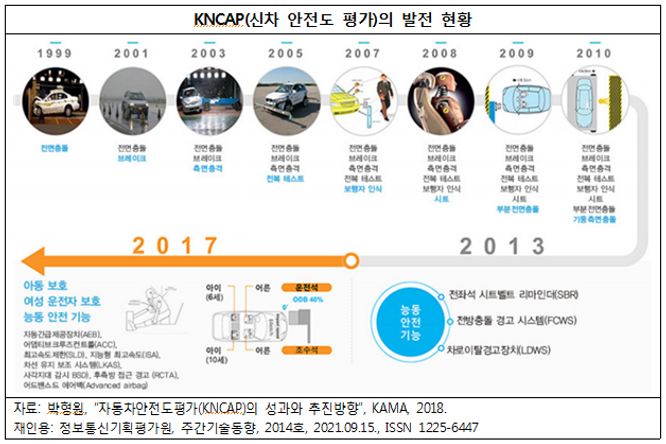Current state of development of domestic self-driving technology and necessity of ADAS inspection technology

The Ministry of Land, Infrastructure, Transport and Tourism is promoting various related support projects with the goal of completing technology development at level 4+ of self-driving by 2027 and establishing a commercialization foundation. Self-driving level 4 is a level where “high-automatic driving” is possible, and the automated system of the vehicle recognizes and determines the situation and the vehicle can handle it itself in case of emergency without driver intervention.* Level 4+, announced by the government, is a more extended term that includes the infrastructure and social services that enable level 4 self-driving, as well as level 4 self-driving. So how far has the level of self-driving reached in the country?

Self-driving cars currently on sale are at levels 2 to 2.5 and Hyundai Motor is set to launch its first Level 3 mass production vehicle in the country in the second half of this year.Self-driving technology is thus rapidly evolving, reaching the “Mind Off” level, which eliminates the need for driver intervention when level 4 or higher self-driving cars are commercialized. Development stage of self-driving technology, American Automotive Engineering Association (SAE) standard

Level 0 Level 1 Level 2 Level 3 Level 4 Level 5 Deautomated Driver Auxiliary Partial Automation Conditional Automation Advanced Automation Fully Automated Hands On Hands On Eyes OffMind OffDriver Off

Level 0 Level 1 Level 2 Level 3 Level 4 Level 5 Deautomated Driver Auxiliary Partial Automation Conditional Automation Advanced Automation Fully Automated Hands On Hands On Eyes OffMind OffDriver Off

Level 0 Level 1 Level 2 Level 3 Level 4 Level 5 Deautomated Driver Auxiliary Partial Automation Conditional Automation Advanced Automation Fully Automated Hands On Hands On Eyes OffMind OffDriver Off

However, even Level 2 self-driving cars have experienced traffic accidents due to ADAS malfunctions and malfunctions. Therefore, it is necessary to develop advanced inspection technology to inspect the performance of vehicles equipped with ADAS and to ensure the safety of more advanced self-driving vehicles to be released in the future. Emergence of the need to develop inspection technology for vehicles equipped with ADAS
.jpg)
As self-driving technology becomes more sophisticated, the need for systematic inspection technology to accurately and effectively test ADAS/automatic driving performance is increasingly emphasized. Germany, an advanced country in automotive technology, conducts periodic inspections (PTI, Periodic Technical Inspection) to assess the safety of some advanced safety devices.However, with the enactment of the Traffic Safety Act and the Automobile Management Act, the mandatory installation of high-tech safety devices has been expanded, but the inspection technology for cars equipped with high-tech safety devices is insufficient. Development of Inspection Technology for Future Automotive Performance EvaluationRecently, the Korea Transportation Safety Corporation (TS) under the Ministry of Land, Infrastructure and Transport has established a high-tech safety device inspection test bench in cooperation with various institutions and companies such as dSPACE and Durr. The test bench uses dSPACE simulators to virtually implement the vehicle’s road driving environment, to implement sensor-specific operating environments through radar target simulators (RTSs), and to test the performance of ADAS on actual vehicles such as AEB, LKAS, FCWS and LDWS. Learn more about ADAS (Advanced Safety Equipment) Test Bench (feat.ADAS Functional Description)[dSPACE-Durr]Vehicle-in-the-loop test implementation for ADAS/Automatic Driving Functional Inspection (With Korea Transportation Safety Authority) [dSPACE-Durr]Vehicle-in-the-loop test implementation for ADAS/Automatic Driving Functional Inspection (With Korea Bridge…blog.naver.comIn March this year, we had time to comprehensively test various high-tech safety devices (ADAS) through the demonstration of “Results in the Development of Advanced Safety Equipment (ADAS) Equipped Vehicle Performance Evaluation and Inspection Technology” hosted by the Korea Transportation Safety Corporation. Learn more about the demonstration of “Results on the Development of Advanced Safety Equipment (ADAS) Vehicle Performance Evaluation and Inspection Technology.”dSPACE participates in the demonstration of “Results in Development of Advanced Safety Equipment (ADAS) Equipped Vehicle Performance Evaluation Technology” dSPACE, Korea Transportation Safety Corporation (TS) sponsored “Advanced Safety Equipment (ADAS)” blog.naver.comIn the future, dSPACE will continue to work with various institutions and companies to build a safer era of self-driving.* Reference: Kang Myung-do Yeo Eun-seok (2019). A Study on the Necessity of Periodic Inspection Technology for Advanced Driving Support Systems. “Korea Automotive Engineering Association’s dissertation.” No. 166 pp. 741-743, Korea Automotive Engineering Association.dSPACE Korea Simulation and Validation Partner [email protected] 02-1931-9110dSPACE Korea Simulation and Validation Partner [email protected] 02-1931-9110